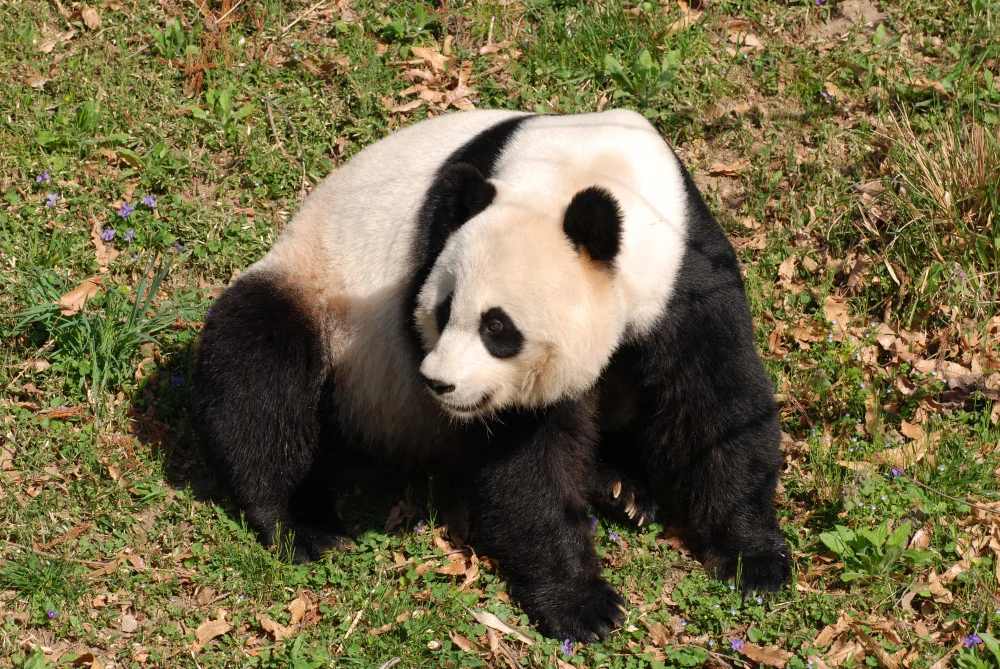Table of Contents
ToggleHabitat and Distribution:
The Giant Panda, scientifically known as Ailuropoda melanoleuca, is native to the mountain ranges of central China, primarily inhabiting bamboo forests at elevations between 1,200 and 3,400 meters (4,000 to 11,000 feet).
Physical Characteristics:
- Size and Weight: Giant Pandas are medium-sized bears, with adults typically weighing between 75 to 160 kilograms (165 to 350 pounds). They measure about 1.2 to 1.9 meters (4 to 6 feet) in length.
- Appearance: They have a distinctive black and white fur coat, with black fur patches around their eyes, ears, shoulders, and legs, while the rest of their body is covered in white fur.
- Adaptations: Giant Pandas have a specialized thumb-like structure called a pseudo thumb, which is actually an enlarged wrist bone covered in skin, enabling them to grasp bamboo stems efficiently.
Diet and Feeding Habits:
- Bamboo Consumption: Giant Pandas are primarily herbivores, with bamboo making up over 99% of their diet. They consume various species of bamboo, preferring tender shoots and leaves.
- Digestive System: Despite being carnivores anatomically, their digestive system has adapted to a plant-based diet, though inefficiently. They have a large digestive tract and spend most of their day eating and digesting bamboo.
Behavior and Lifestyle:
- Solitary Animals: Giant Pandas are generally solitary animals, except during the mating season or when raising offspring.
- Territorial Behavior: They have large home ranges that they mark with scent glands to communicate their presence and avoid conflicts with other pandas.
- Activity Patterns: Giant Pandas are crepuscular, being most active during the dawn and dusk hours. They spend the rest of their time resting or sleeping to conserve energy.
Reproduction and Life Cycle:
- Mating Season: The breeding season typically occurs in the spring, between March and May.
- Gestation Period: Female pandas have a gestation period of around 3 to 5 months, after which they give birth to one or two cubs.
- Cub Rearing: Panda cubs are born blind and helpless and remain dependent on their mother for care and nourishment for about 18 months to 2 years.
Conservation Status and Threats:
- Endangered Status: The Giant Panda is classified as Endangered on the IUCN Red List due to habitat loss, fragmentation, and poaching.
- Conservation Efforts: Various conservation initiatives, including habitat protection, captive breeding programs, and reforestation efforts, aim to conserve Giant Pandas and their habitats.
Cultural Significance and Symbolism:
- Cultural Icon: Giant Pandas hold significant cultural importance in China and globally, symbolizing wildlife conservation and environmental protection.
- International Diplomacy: China often engages in panda diplomacy, loaning pandas to other countries as a gesture of friendship and cooperation.
Economic and Ecological Importance:
- Tourism: Giant Pandas are a major tourist attraction, drawing millions of visitors to panda reserves and conservation centers in China.
- Ecological Role: As bamboo eaters, Giant Pandas play a crucial role in shaping bamboo forest ecosystems, influencing plant diversity and forest regeneration.
Challenges and Future Prospects:
- Habitat Fragmentation: Fragmentation of bamboo forests poses a significant threat to Giant Panda populations, limiting their habitat and food sources.
- Climate Change: Climate change may exacerbate habitat loss and impact bamboo availability, further endangering Giant Pandas in the wild.
In summary, the Giant Panda is a fascinating and iconic species that faces numerous conservation challenges. Through concerted conservation efforts and international collaboration, there is hope for securing a sustainable future for this beloved bear species.

